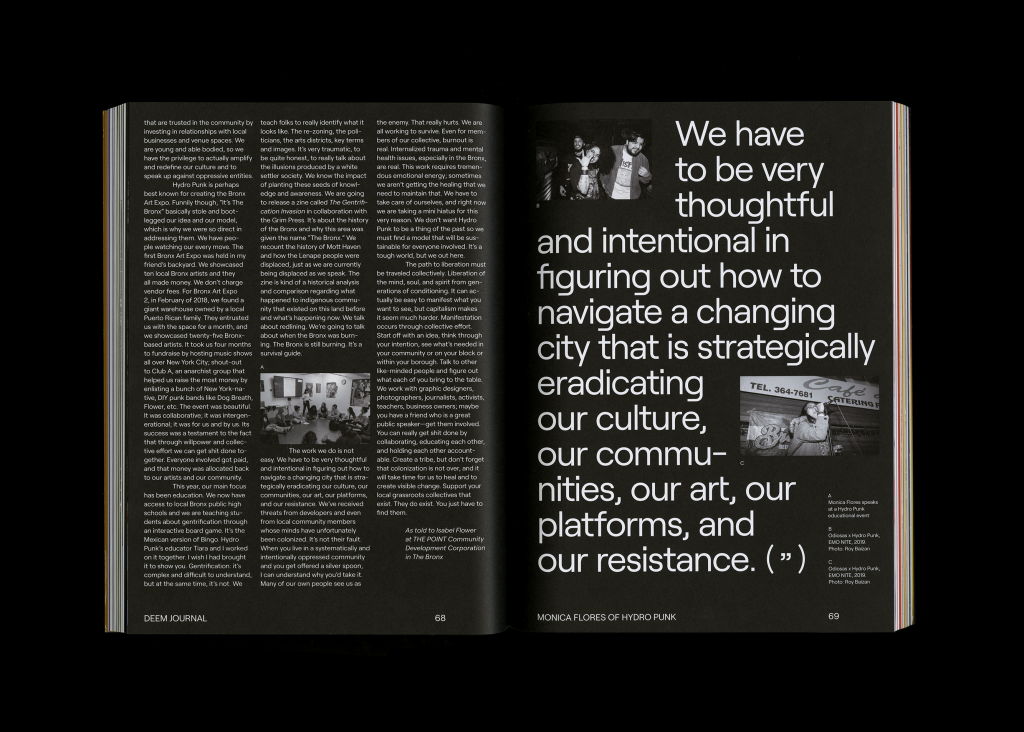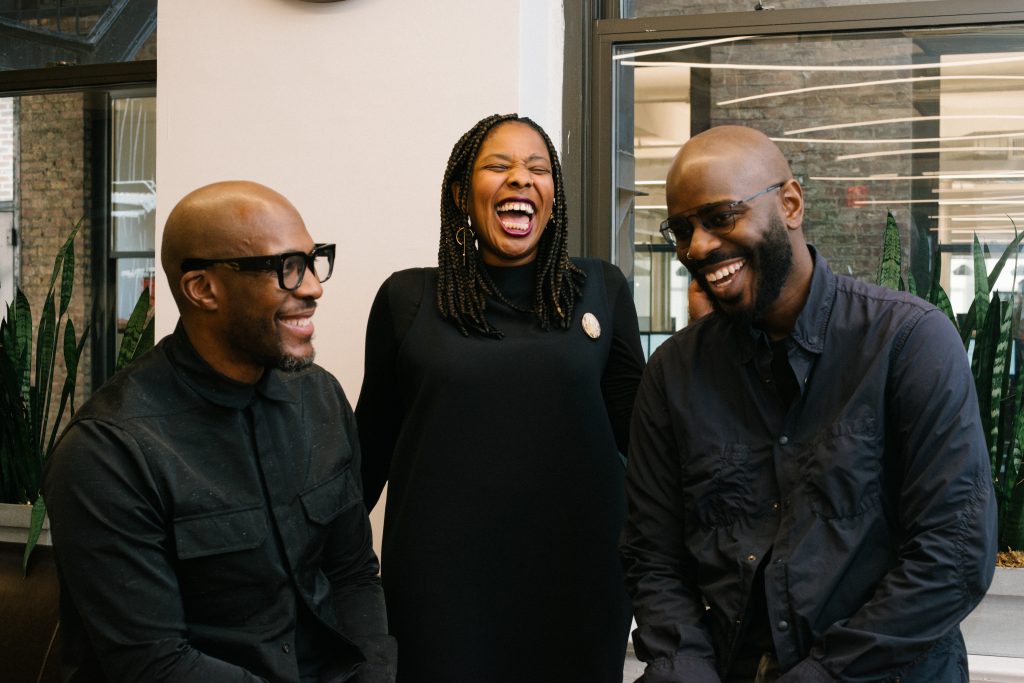Deem Journal Amplifies Marginalized Voices in Design
The biannual LA-based print magazine positions design as a “social practice” accessible to all

Co-founded by a trio of Black creatives, print publication Deem Journal presents design as a “social practice,” challenging its readers to reconsider its traditional boundaries. Each founder—Nu Goteh (a multi-disciplinary designer and co-founder of strategy and design studio Room for Magic), Alice Grandoit (a cultural researcher, non-profit developer and co-founder of Room for Magic) and Marquise Stillwell (the founder of Openbox, a NYC-based design studio and consultancy)—brings valuable insight to Deem’s development.

Their first issue, Designing for Dignity, employs long-form journalism to tell the stories of those oftentimes left out of design conferences, conventions, agencies and big-budget projects. “When you read our first issue, you can see that we were already writing in what was not only going to happen but also speaking to this exact moment, which reinforces why the voices of Black people need to be at the forefront of this moment of change and the platform we are building is perfectly poised to do that,” Goteh says of the debut issue, which features author Adrienne Maree Brown on its cover. Deem makes space for Black voices—and it does so in a tangible manner. Ahead of delivery of Deem’s inaugural issue, we spoke with Goteh and Stillwell about the launch and what it means for them and readers.

I want to start with your mantra, or the foundation, for Deem, which is to position design as a “social practice.” Can you expand upon that?
Nu Goteh: When we were looking at creating a publication, a couple of things came to mind and were the overlap between Marquise, Alice and I: whenever we would talk about design, or start to think about design, we would see that design was always attached to output, and those outputs would usually be graphic design, industrial design or some other form. We saw that whenever you spoke about design, it was usually practitioners talking to other practitioners and those practitioners usually were white males who said, “Hey, here are things I’ve created that other people are then consuming or other people are then utilizing.” But when we boiled design down to its raw essence, we found that design is just the act of adding value and finding different places and spaces to add value. Then we started to think about what happens when you detach design from an output. What happens when you frame design as an act of adding value? It starts to free you up to have more nuanced conversations with people who don’t consider themselves traditional designers or people who who have not been exposed to design in a formal way.
Design as a social practice is really us flipping design on its head and using social practice, which is an art form driven by engagement, to look at design from an engagement standpoint. Once you start looking at design from an engagement standpoint, it starts to open up and allow many more voices, many more people to participate and see themselves in design.

Design is inherently abstract but often with physical results. To break it from it from that, in a way, forces everyone to realize that, to a degree, everything is design or everything has been designed. Is that how you’re pulling people in who haven’t seen themselves in design?
Marquise Stillwell: Yeah. Design is an iterative process, and through that iterative process there’s exchanged value that everyone adds to. It’s different than jazz as a music form, which is an iterative process of continuing to add as it continues to expand and grow, whether it’s a session and you’re literally playing or over history as people continue to build off it. It’s not always just about the output. It is about the process and sharing back and forth, and there are plenty of people who are in different situations that may not consider themselves designers but because of the process of continuing to live and adapt their behavior, they’re designers.
We’re probably in the greatest design experiment of all time with COVID, and I’m fascinated by seeing how everyone is trying to adapt. I’m fascinated to see, every time I walk into a location, how they’ve adapted their space—watching and seeing how people are adapting, from pushing buttons to get into the elevator to checking into the hotel. Is that design as a social practice? Absolutely, and that’s really where the core of the thinking comes from.

Are you trying not only to relay stories of non-traditional designers and design ideas but also change, or impact, the mindset of who’s reading—whether they’re from the “design world” or not?
NG: The entire platform’s main goal, from how we named it to how we started to approach editorial, is to empower anyone to feel that they can have a seat at the table. For us, our lens is usually looking at solutions, community-driven solutions—things that are coming from outside of the typical world of design. Empowerment is something that we practice and that the publication was meant to practice. And like Marquise was saying, we lean more into the process than the output because the output is driven by fidelity, and fidelity is driven by what types of resources you have to bring your concept to life. But anyone can look at a process and then be inspired by that process and figure out how they can either implement that process or improve on their own.

With this first issue, “Designing for Dignity,” who is represented here? What do you hope resonates with the readers?
NG: Us thinking about “Designing for Dignity” really started off with more questions. Even though it’s a statement, it’s really a question, or a hypothesis—it’s us examining “what is dignity?” Who gets to qualify and quantify what a dignified life is? Who’s actually contributing to that and where are those places that we can focus on to start to move closer to creating a dignified life that anyone can opt into. And so one of the different paths we went down was looking at food, your local food systems. Where do our food systems come into play in terms of living a dignified life? Who is getting the best type of food? Who is trying to find solutions around being able to get better nourishment? From there, you start to look at social architecture. What happens when architects stop looking at just the built wall and start thinking about how that wall is engaging with the people who are living there?

We’re also looking at co-living. We’re moving into a space now where there are housing shortages and population growth is at an all-time high. We need to start thinking about new ways of living together. And what does living together look like? When we took this approach, our goal was that anyone, at any spectrum of what they consider to be a dignified life, can pick it up and find something resonates with them. Whether it is the practitioner who is an architect or someone who has a garden bed in their backyard and they’re excited because they grew their own kale. Our goal was not just to focus on practitioners but also focus on potential end users or anyone who wants to contribute.

Is there then space in Deem for institutions and established designers too?
MS: Absolutely. We definitely have your traditional designers who have also been underrepresented in this conversation. I would say, even as someone who has a design firm, I have designers and people that come from those traditional backgrounds, that they’re also looking for new ways to express their practice in a more meaningful way and not becoming trapped in some Six Sigma process of one, two, three and out pops the magic button, you know? For us, I do believe we present an important intersection for those that are practitioners to intersect with individuals that have been doing this in a different way, as well as people who have been doing it in a different way to see how the work they’ve already been doing has framework that they can continue to build upon.
NG: Another role we see traditional designers playing is through empowering. Not only are they designing outputs but also conditions, ones that allow other people who aren’t traditionally designers to then contribute and drive.

When you mention the framework, do you mean a framework for the future? A future these individuals could design for themselves using Deem as a reference point or a resource?
MS: Absolutely. In many ways we’re hoping that Deem, as a journal, is not a quick read, but a place people can continue to come back to. We may have had to label this issue one just so that everyone understands that there’s some sequencing but, to be honest with you, there’s really no sequencing. We’re hoping that after a while we’ll have a library of journals that people can continue to go back to as a resource—something that’s outside the traditional practitioner space. That it serves as a resource to remind, to inform, to engage, to continue to push their curiosity and allow us all to see a better future.

The call to action is you. I think there are too many design magazines out there where the call to action is to go get an object, go get a thing. What we want to do is provoke people to take action themselves, regardless of where they’re coming from. And that can be a bit overwhelming and a bit vulnerable, but I do believe, as designers, we do our best to embrace that every day and hopefully we can serve as a means for doing that for someone else.
Images courtesy of Deem and respective photographers where noted












